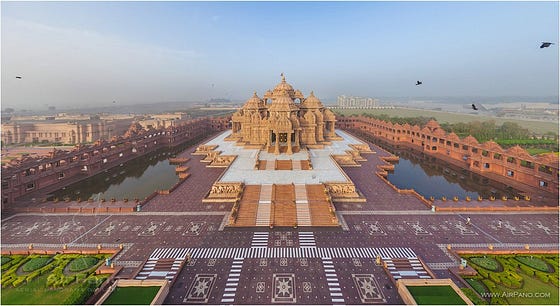Swaminarayan Sampradaya and the Creation of Akshardham


Swaminarayan Sampradaya: Origins and Beliefs
The Swaminarayan Sampradaya is a Hindu Bhakti tradition founded by Bhagwan Swaminarayan (born Sahajanand Swami), who emerged as a charismatic leader in early 19th-century Gujarat. The tradition developed from Ramanand Swami’s Uddhav Sampraday, itself rooted in the Sri Vaishnavism of Ramanuja and the philosophy of Vishishtadvaita. Swaminarayan institutionalized his teachings by constructing temples (mandirs), creating a scriptural tradition, and establishing two main dioceses (gadis): the Laxmi Narayan Dev Gadi (Vadtal) and Nar Narayan Dev Gadi (Karnavati), each with hereditary acharyas as spiritual heads.

Swaminarayan’s teachings emphasize the ultimate goal of becoming Brahmarūpa — attaining the form of Aksharbrahman and thus liberation from the cycle of birth and death (moksha). His theology distinguishes between Parabrahman (the Supreme God, Purushottama or Narayana) and Aksharbrahman as two distinct, eternal realities, a concept especially highlighted in the BAPS (Bochasanwasi Akshar Purushottam Swaminarayan Sanstha) branch as the Akshar-Purushottam Darshan.
He advocated for social reforms, including ethical living, non-violence, and the inclusion of all castes, and inspired followers to observe five basic principles: addiction-free living, vegetarianism, refraining from theft, abstaining from adultery, and maintaining purity of mind, body, and soul.
Creation of Akshardham
Akshardham refers both to the divine abode of Swaminarayan in the tradition’s theology and to a series of monumental temple complexes created by the Swaminarayan Sampradaya, particularly by BAPS.
Swaminarayan Akshardham (Delhi)

Swaminarayan Akshardham in Delhi is a grand temple and cultural complex constructed by BAPS, inspired by Yogiji Maharaj and realized under the leadership of Pramukh Swami Maharaj. The temple was officially opened on 6 November 2005. It is the world’s second-largest BAPS temple after Akshardham in New Jersey, USA.

The complex showcases millennia of Hindu culture, spirituality, and architecture. The main shrine (Akshardham Mandir) is the focal point, constructed entirely from Rajasthani pink sandstone and Italian Carrara marble, following traditional Hindu architectural principles without the use of steel or concrete. The temple features 234 ornately carved pillars, nine domes, and 20,000 murtis (sacred images) of swamis, devotees, and acharyas. The central murti is an 11-foot high image of Swaminarayan in abhayamudra, surrounded by images of the faith’s lineage of gurus.

The complex also includes exhibition halls (such as Sahajanand Darshan, Neelkanth Darshan, and Sanskruti Darshan), a musical fountain (Sahaj Anand water show), and thematic gardens.

These exhibitions use modern technology to narrate the life and teachings of Swaminarayan and the values of the tradition
Theological Significance
In Swaminarayan Hinduism, Akshardham is not just a physical temple but represents the divine abode of Swaminarayan, where liberated souls (Aksharmuktas) offer pure worship to Parabrahma (God). The temple complexes are seen as temporal representations of this spiritual ideal on earth, aiming to inspire visitors toward moral and spiritual upliftment.
In summary: The Swaminarayan Sampradaya is a major modern Hindu tradition distinguished by its unique theology and social reforms. Its most visible modern expression is the Akshardham temple complexes, which serve as both devotional centers and showcases of Indian culture, spirituality, and the teachings of Swaminarayan.



Comments
Post a Comment